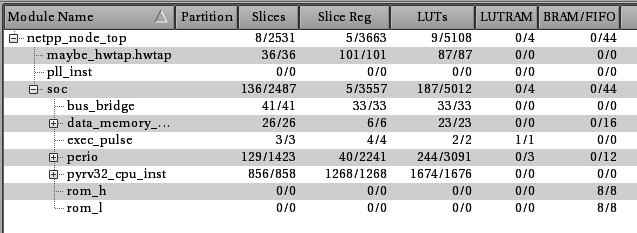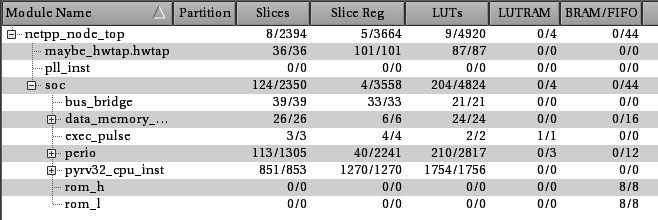Find the a (currently unstable) development branch here:
https://github.com/hackfin/MaSoCist/tree/ghdlsynth_release
NOTE: In process of upgrading to ghdl v1.0 synthesis. The build system is currently not functional. Use the self extracting script from the Instructions (2) below for a frozen working configuration.
Configurations that work (from those appearing when you run ‘make which’ in the masocist top dir):
- *-zpu-ghdlsynth: ZPUng setup with ‘beatrix’ configuration.
- *-pyrv32-ghdlsynth: RISC-V 32 bit basic configuration, proof of concept only, not fully functional as SoC in synthesis (as of now)
Note: You need to explicitely install the rv32 toolchain (inside the docker container) for this config:sudo apt-get install riscv32-binutils riscv32-gcc riscv32-newlib-libc
Instructions
This can be done online in a browser, if you don’t run Linux, see also https://section5.ch/index.php/2019/10/24/risc-v-in-the-loop/.
Note: Since this setup depends on external packages, there is no guarantee it will build smoothly.
- Run docker container with exported USB devices (if you want to program the plugged in board right away):
docker run -it --device=/dev/bus/usb hackfin/masocist:synth - Pull synthesis self-extracting build script:
wget https://section5.ch/downloads/masocist-synth_sfx.sh && sh masocist-synth_sfx.sh - Pull packages and build:
make all - Configure platform:
cd src/vhdl/masocist-opensource;
make versa_ecp5-zpu-ghdlsynth - Build for synthesis:
make clean sw syn - When successful, you’ll end up with a $(PLATFORM).SVF file in
syn/. - See next paragraph on how to program the board (this procedure will be simplified)
Supported boards
Currently, the following ECP5 based boards are supported/under scrutiny:
- Lattice Versa development kit [Lattice Semiconductor product page]
- Testing: EVDK/VIP stereo sensor development kit [Lattice Semiconductor product page]
Programming with on board FT2232H JTAG interface:
Note that programming will only work when the container is run/started after plugging in the board.
To program the FPGA SRAM on the board with the produced SVF file:
- Make sure board is connected via USB and powered up.
- You may need to restart the container from above:
docker start -i <id>
where ‘id’ is the container id of the above stopped container (retrieve from shell history or withdocker ps -a) - Install openocd:
sudo apt-get install openocd - Make sure board is connected via USB and powered up, then run, inside $(MASOCIST)/syn:
make download OPENOCD="sudo openocd" - If you see a lot scrolling by, board programming tends to be successful (interface was recognized). You can ignore errors like:
Error: tdo check error at line 26780
as they are due to the changed USERCODE. - You should see the segment display on the board ‘spinning’. Also, you can talk to the SoC through the UART at 115200, 8N1, for example using minicom:
minicom -o -D /dev/ttyUSB1
The output upon booting of the SoC should be:
Probing flash…
Flash Type: m25p128
Booting beatrix HW rev: 04 @25 MHZ
------------- test shell -------------
-- SoC for Versa ECP5 --
arch: ZPUng
-- (c) 2012-2020 www.section5.ch --
-- type 'h' for help --
Quirks
Short summary on what works in particular and what does not:
Ram inference
RAM inference is currently problematic and needs to be investigated further. TODO:
- Make synthesis recognize more variants of RAM with init values
- Implement dual process true dual port RAM
- Fully eliminate Verilog RAM wrapper workarounds
FSM optimization
Some FSM seem to optimize away in yosys. Needs to be investigated if it’s a VHDL synthesis or internal Yosys issue.
Vendor primitives
Vendor specific Black Box primitives will no longer have to be wrapped starting with new ghdl-1.0 releases (Container namehackfin/masocist:synth-1.0). However, for the time being you might want to visit:
https://github.com/ghdl/ghdl-yosys-plugin/issues/46
So far tested primitives within MaSoCist:
- JTAGG: Test access port to ZPUng and pyrv32 for JTAG debugging or automated in circuit emulation hardware tests.
- EHXPLLL: PLL primitive for clock frequency conversion
- USRMCLK: Access to SPI master clock on ECP5
Not working
System Interrupt Controller (CONFIG_SIC) is currently not supported:#1140
Fixed. Make sure to install the up to date debian GHDL packages when reusing an old container:sudo apt-get update; sudo apt-get install ghdl ghdl-libs
You also have to rebuild the ghdl.so module insrc/ghdl-yosys-plugin:make clean all; sudo make install- FLiX DSP and JPEG core unsupported (due to true dual port RAM issues)
- Under scrutiny: pktfifo (CONFIG_MAC) problematic (TDP BRAM issues)
- Post map simulation does not work with DP16KD primitives, due to missing ‘whitebox’ model, see also #32. You will have to separately use the supplied vendor model from the Diamond libraries.


